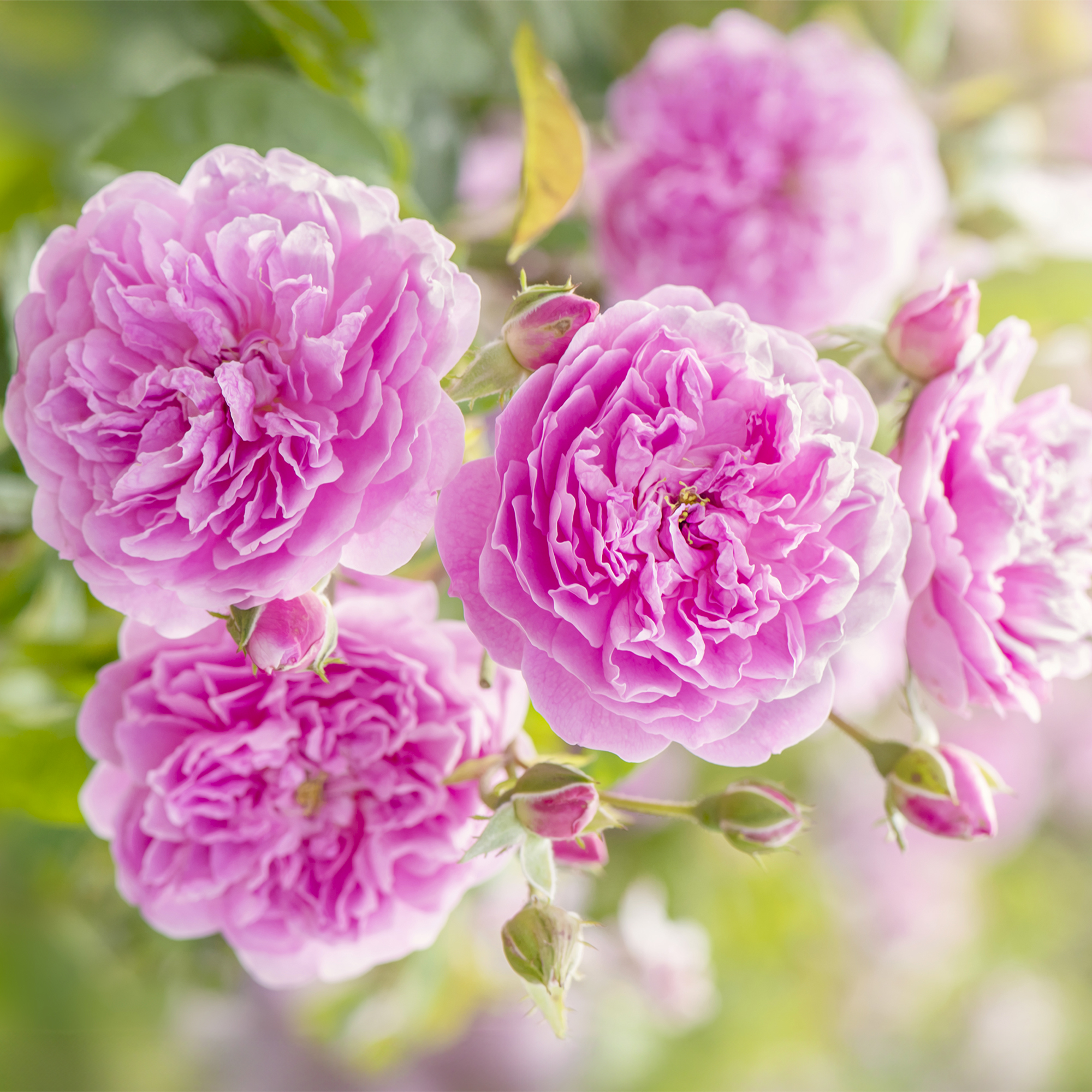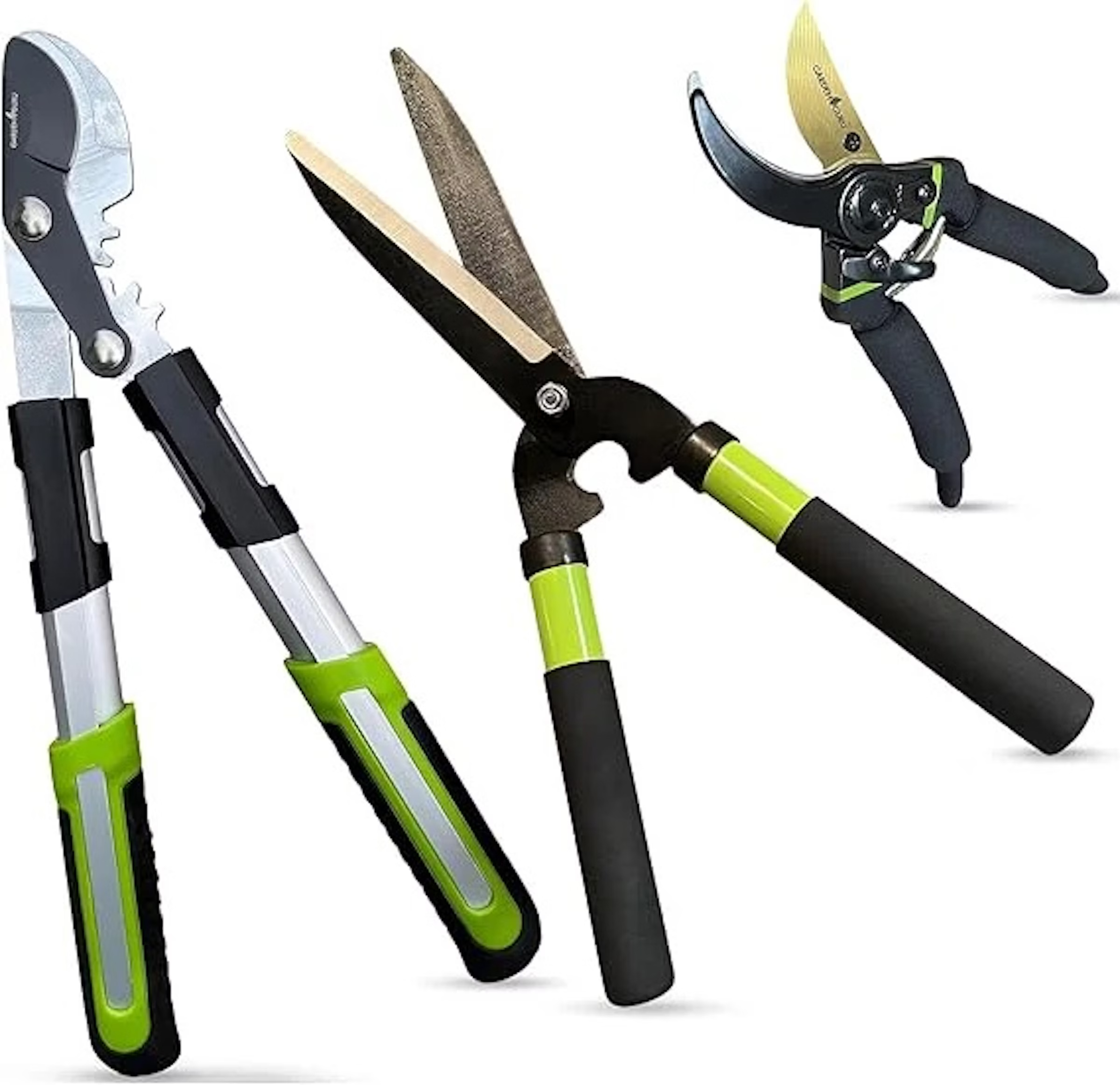Growing Climbing Roses: How To Create Elegant Displays With Maximum Blooms
Master the art of growing stunning climbing roses with this essential guide to creating vibrant, fragrant walls and structures all summer long.
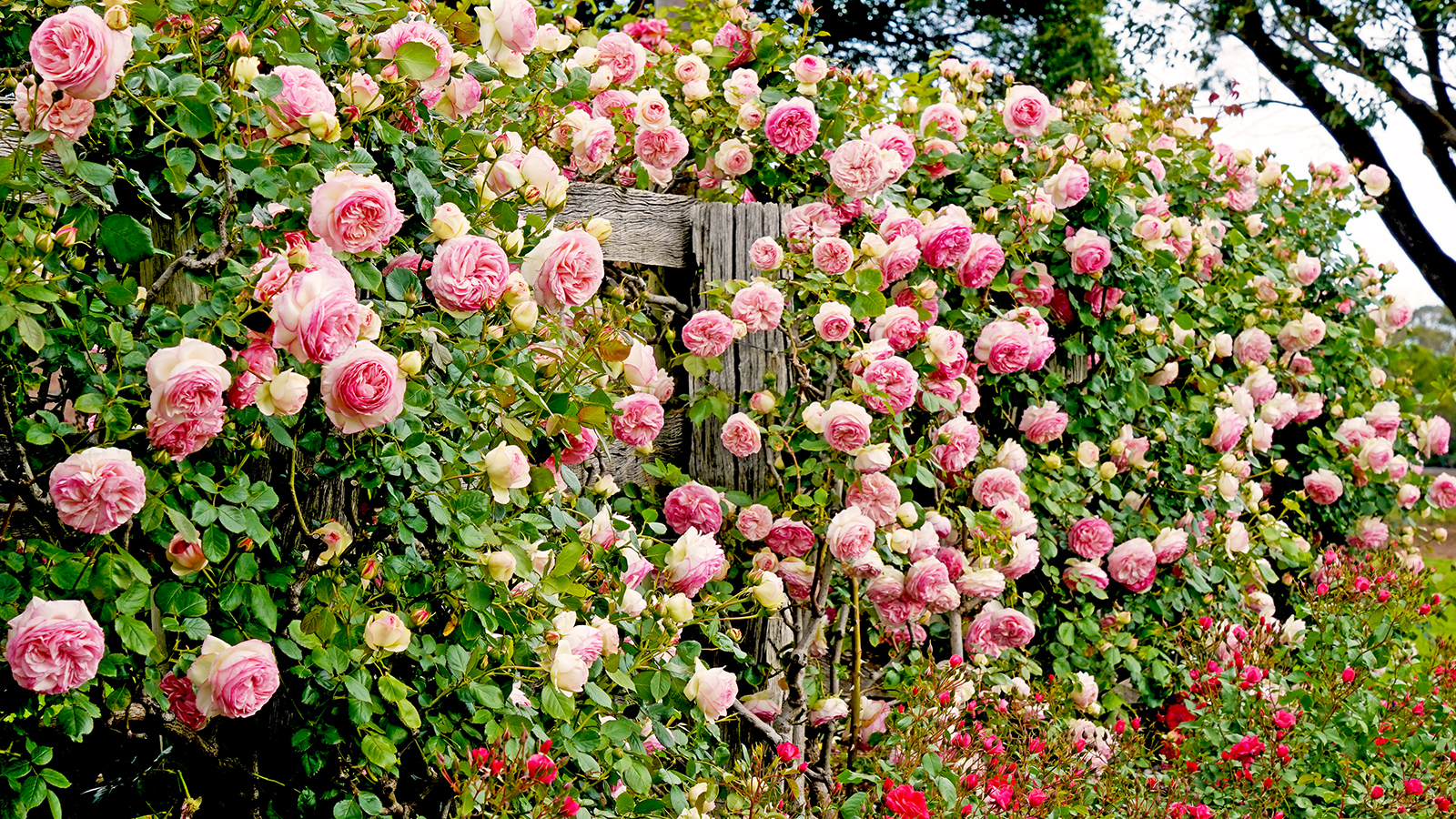

If you haven't tried growing climbing roses in your garden, then you are missing out on some of the most beautiful, versatile plants and design features. Whether arching over a gate or arbor, or spreading across a sun-drenched wall, a climbing rose brings elegance and romance to any garden and is a sight to behold in full bloom. Fragranced varieties fill the air with the most glorious perfume and offer a feast for the senses.
Out of all the types of roses, climbers tend to intimidate beginners the most. While not by any means low maintenance, climbing roses are hardy plants. It takes a lot to kill one, and they usually bounce back from a period of neglect or overzealous pruning. Their diva reputation stems from the need for training as well as the wide number of possible diseases and pests the plants can face. However, if the right varieties are chosen – and basic climbing rose care is observed – then most gardeners won't experience many problems.
If you already know how to grow roses, then caring for a climbing rose will come easily. Still, there are some differences, in particular with regards to pruning, so it's vital to understand their requirements if you want to get the best out of them.
Choosing the Best Climbing Rose Varieties
What makes climbing roses different from rose bushes is that they grow long, flexible canes that can be trained to cover a surface. It's important to choose a variety with a mature size compatible with your garden, as heights range from around 8 feet (2.5m) to over 20 feet (6m) tall.
Some of the tallest climbing roses are actually rambling roses, which tend to grow more vigorously and have more flexible canes. Unlike most climbing roses, which are usually repeat-blooming, ramblers are single-blooming, producing one dense flush of flowers each year, usually in midsummer. The other key difference is that ramblers flower on old growth, and so must be pruned at the end of summer, while climbers bloom on new growth.
The flower appearance of climbing roses can vary dramatically between varieties. Bloom styles include single, semi-double, and double flowers, and they come in a diverse color palette to complement any planting scheme.
There is a rose variety to suit most scenarios, so consider what is most important to you. Is it prolific flowering, an intoxicating fragrance, disease resistance, or perhaps a rose that's more shade tolerant? If you're a beginner grower, then opt for reliable climbing rose varieties, such as 'New Dawn', 'Gertrude Jekyll', 'Eden', or 'Zephirine Drouhin'.
Sign up for the Gardening Know How newsletter today and receive a free copy of our e-book "How to Grow Delicious Tomatoes".
Planting Climbing Roses
There is a lot of flexibility in when to plant roses, but for best results, stick to early spring or autumn, when the soil is still warm but not soggy.
While potted climbing roses from the garden center look more appealing, and may even possess blooms if left until late spring, bare-root roses, supplied without foliage or potting soil, offer better value for money and often grow to be more resilient in the long run. Potted roses can be planted nearly year-round, while bare roots are best planted between fall and early spring.
You can plant climbing roses in the ground or in containers, although the latter is a better solution for shorter varieties. Choose a pot at least 2 feet (60cm) deep and wide, with good drainage.
Before planting roses, give them a thorough soaking. Dig a hole twice as wide as the root ball and about the same depth. If growing a climbing rose against a wall or fence, it should be positioned about 12 to 18 inches (30 to 45cm) away to give the plant enough airflow and ensure the roots have plenty of access to nutrients and moisture in the soil.
Remove any rocks and debris and amend the soil with organic matter and fertilizer. Sprinkling mycorrhizal fungi over the rose's roots before planting will encourage a stronger, healthier root system. Backfill the hole up to the soil "tide mark" on the stem – or about 2 inches (5cm) above the crown – and firm in the rose. Water thoroughly. Mulching roses after planting helps to keep in moisture, suppresses weeds, and adds further nutrients to the soil.
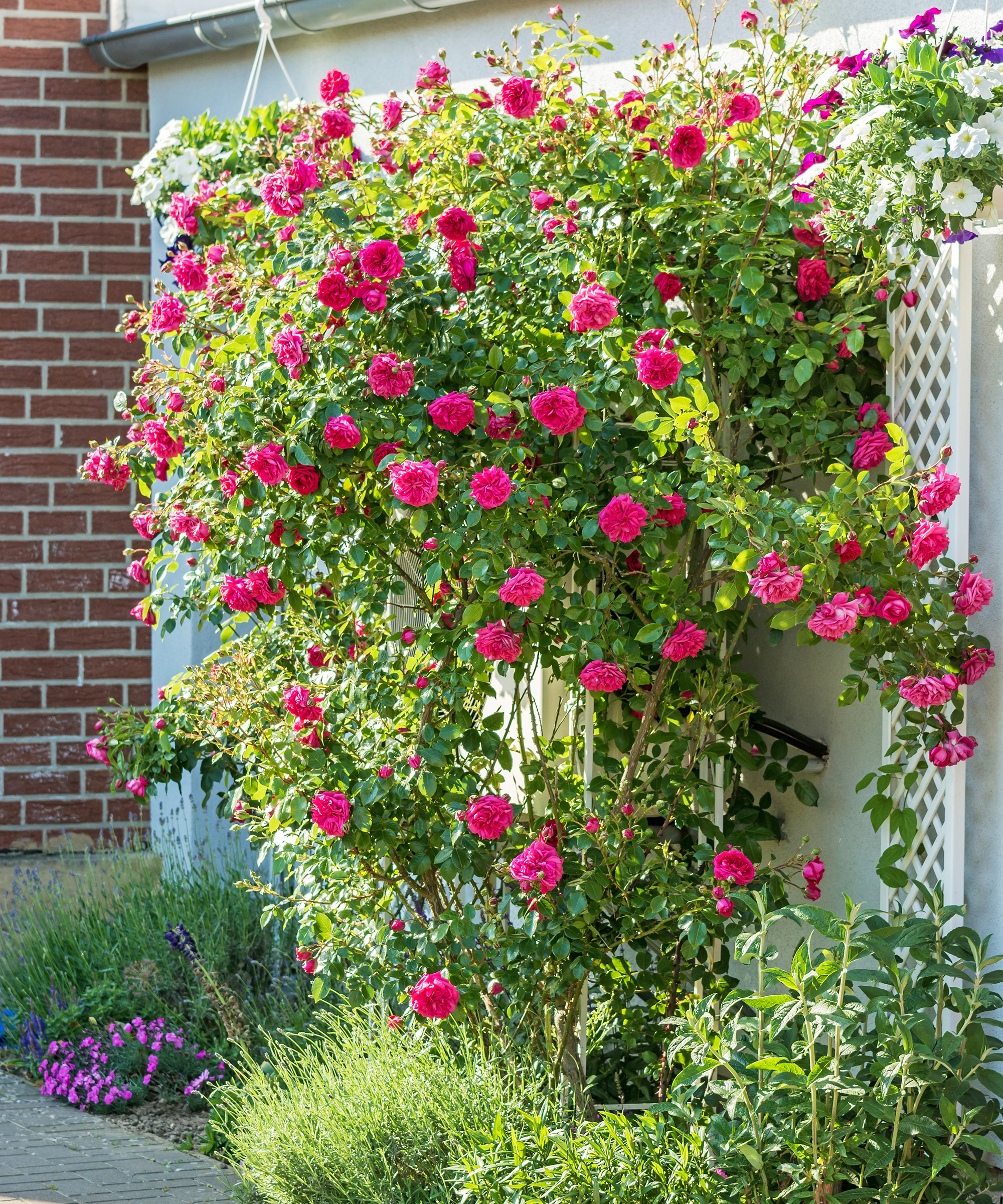
Training and Supporting Climbing Roses
At the time of planting your climbing rose, you will need to add support. Unlike many vining plants, roses don't cling to surfaces by themselves, so they need to be tied in. Choose a suitably sized trellis, wire frame, or pergola. Alternatively, you can affix rows of wire to walls or fences using vine eyes, with rows spaced about 1 to 2 feet (30 to 60cm) apart.
Initially, the rose may be too short to tie in, but as it grows, you need to gently tie the canes using soft ties or garden twine. To encourage more lateral flowering, aim to train the vines horizontally rather than straight up.
When training climbing roses, you need to encourage them in the direction you want them to grow and remove inflexible canes not growing in a suitable direction.
Climbing Rose Care
Though generally hardy, climbing roses are fairly particular about their care. Neglect won't quickly kill plants, but they will simply survive rather than thrive. To encourage lush, healthy foliage and a blanket of glorious, fragrant blooms, there are a few guidelines you must follow.
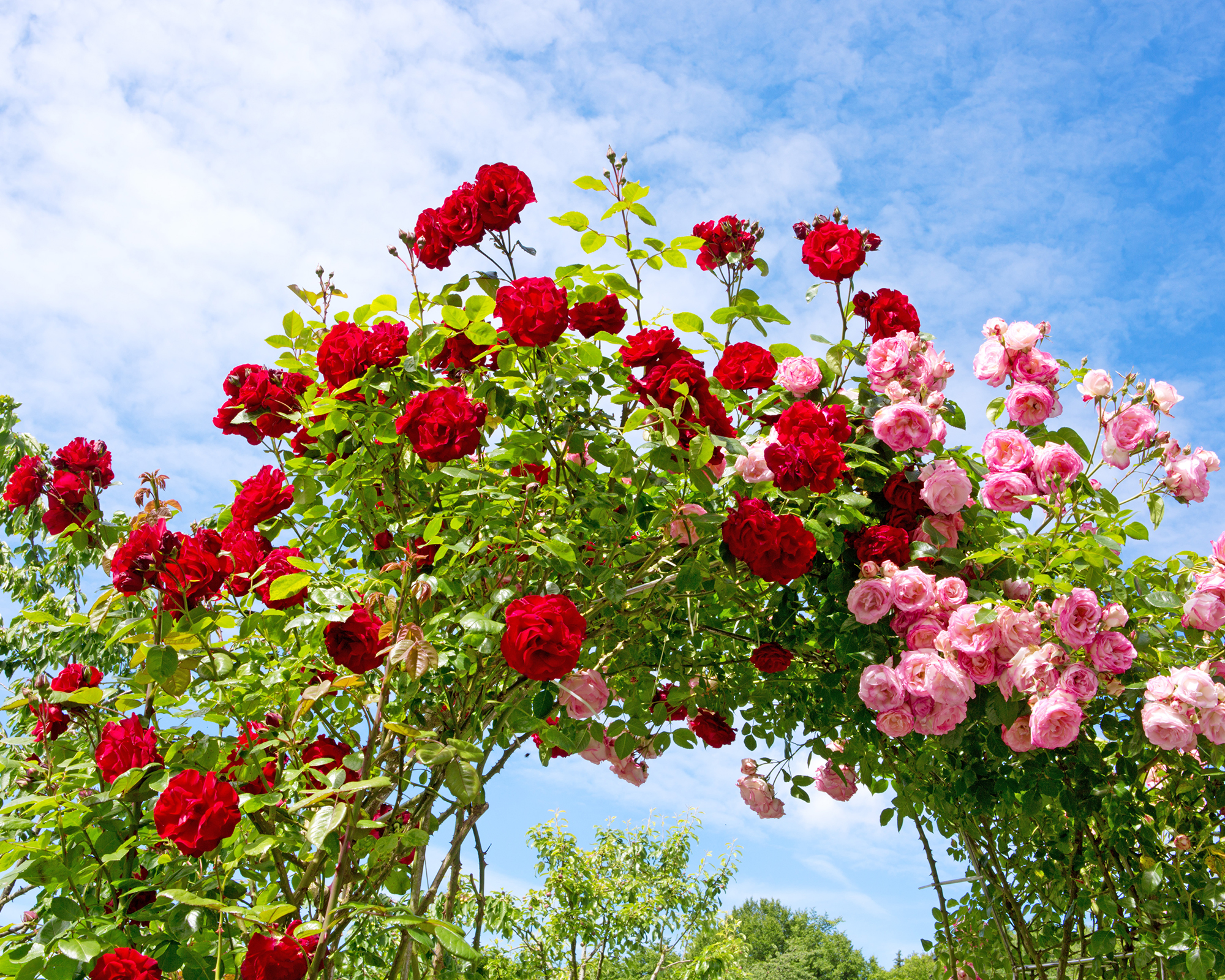
Light
As sun-loving plants, rose light requirements are generally high, and climbing roses are no exception. A lack of light will lead to spindly canes and few flowers. However, full sun all day could lead to wilting and fading.
Choose a spot that receives six to eight hours of full sun each day. In cooler climates, a south-facing wall is ideal, while in hotter zones an east-facing wall will allow the rose to receive plenty of morning sun but some shade in the afternoon.
Water
Climbing roses are thirsty plants, though deep watering when the soil begins to dry out is better than constant light sprinkles. In dry spells, give roses a thorough soaking once or twice a week – more often if the rose is newly planted or in a container. However, rather than watering roses on a schedule, do so when needed. Push your finger into the soil, and if the top couple of inches feel dry, then it's time to water.
Always water the base and avoid splashing water on the leaves. This will help to reduce the risk of mildew and black spot.
Temperature & Humidity
Climbing roses are surprisingly adaptable to different climates and, broadly, can be grown in USDA zones 4 to 11. However, they generally prefer to grow in climates with warm – but not excessively hot – summers and cold winters.
During the main growing season, climbers thrive in temperatures of 60 to 80°F (15 to 27°C). They can tolerate occasional heat waves, but prolonged periods above 85°F (29°C) will stress the plant, leading to smaller blooms with faded petals. They will also need watering much more frequently.
In winter, most climbing roses can handle light frost, but repeated deep freezes – where temperatures dip below 15°F (9°C) – can cause damage to plants. If you live in an area with particularly cold winters, then choose cold-hardy varieties and provide protection from extreme cold, using plenty of mulch and fleece wraps.
Climbing roses dislike high humidity levels, where they are more prone to fungal diseases like black spot, powdery mildew, and rose rust. Choose disease-resistant varieties and prune regularly to keep the foliage structure open and allow air flow. Avoid overhead watering and water early in the morning.
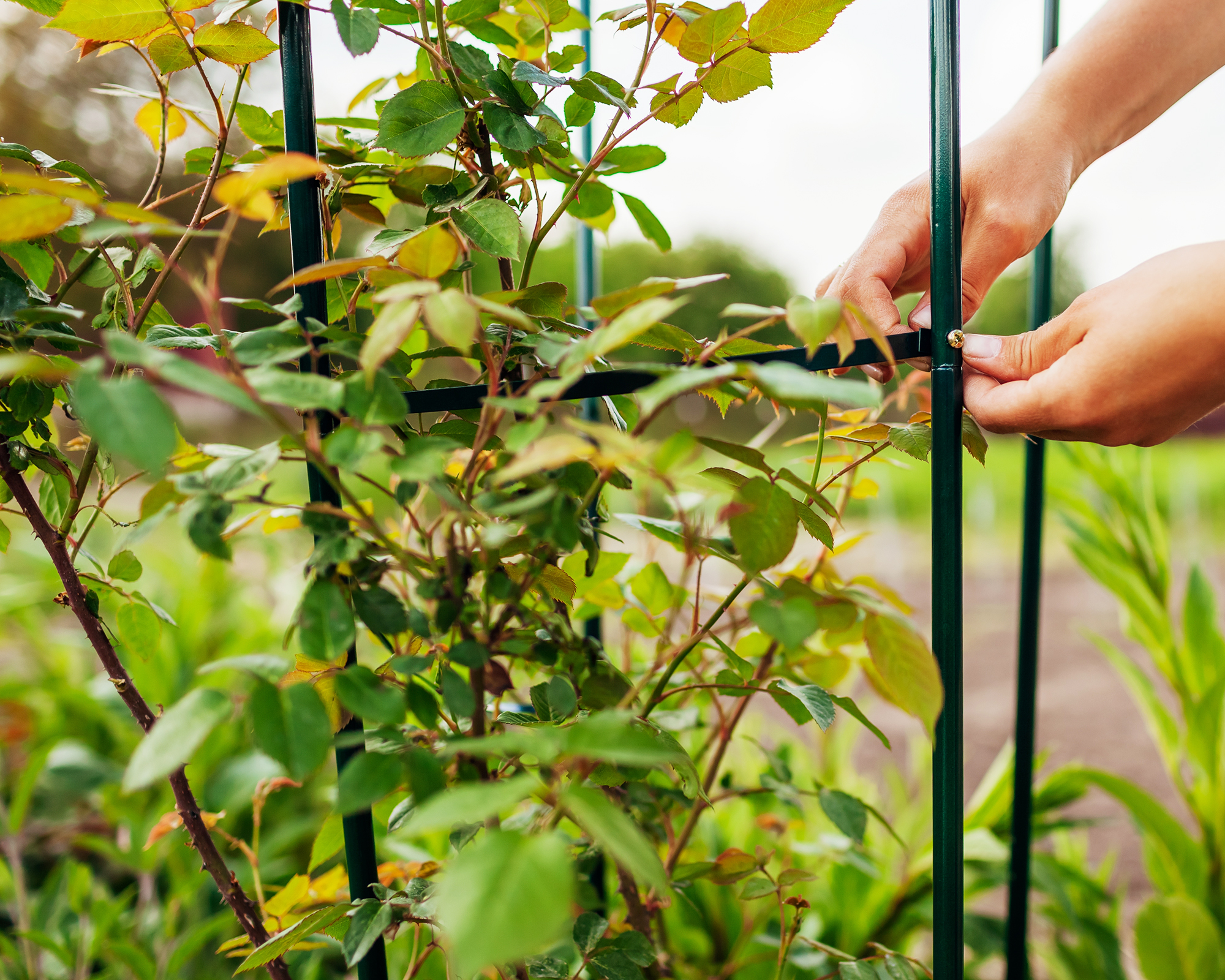
Soil
Climbing roses prefer rich, well-drained loamy soil. Good drainage is key, as the plants' roots need access to moisture but hate to soak in soggy, compacted soil. Heavy clay soil can be lightened with compost and horticultural grit, while sandy soil can be improved with organic matter to help boost water retention.
Roses also prefer a slightly acidic to neutral soil pH in the range of 6.0 to 7.0. If the soil is too acidic, then adding lime will gradually raise the pH, while the pH of alkaline soil can be lowered with sulfur, pine needles, or peat moss. However, changing the pH of soil is not a quick fix – it takes time. So, if the soil pH is far from ideal, then in the short term, it is best to plant roses in containers.
When planting roses, amend the soil with organic matter, such as compost or well-rotted manure. Other good additions include bone meal, ground alfalfa meal, and a few tablespoons of Epsom salts.
Fertilizing
Climbing roses are heavy feeders and require regular feeding to produce abundant blooms. Fertilize roses in early spring at the time of pruning. This will encourage the plant to start putting on fresh growth. Follow up with a second feed just after the first flowering in early summer – this will encourage a second flush of flowers.
Use a balanced rose fertilizer with a balanced NPK, like 10-10-10, in early spring, then switch to a higher potassium formula as the season progresses.
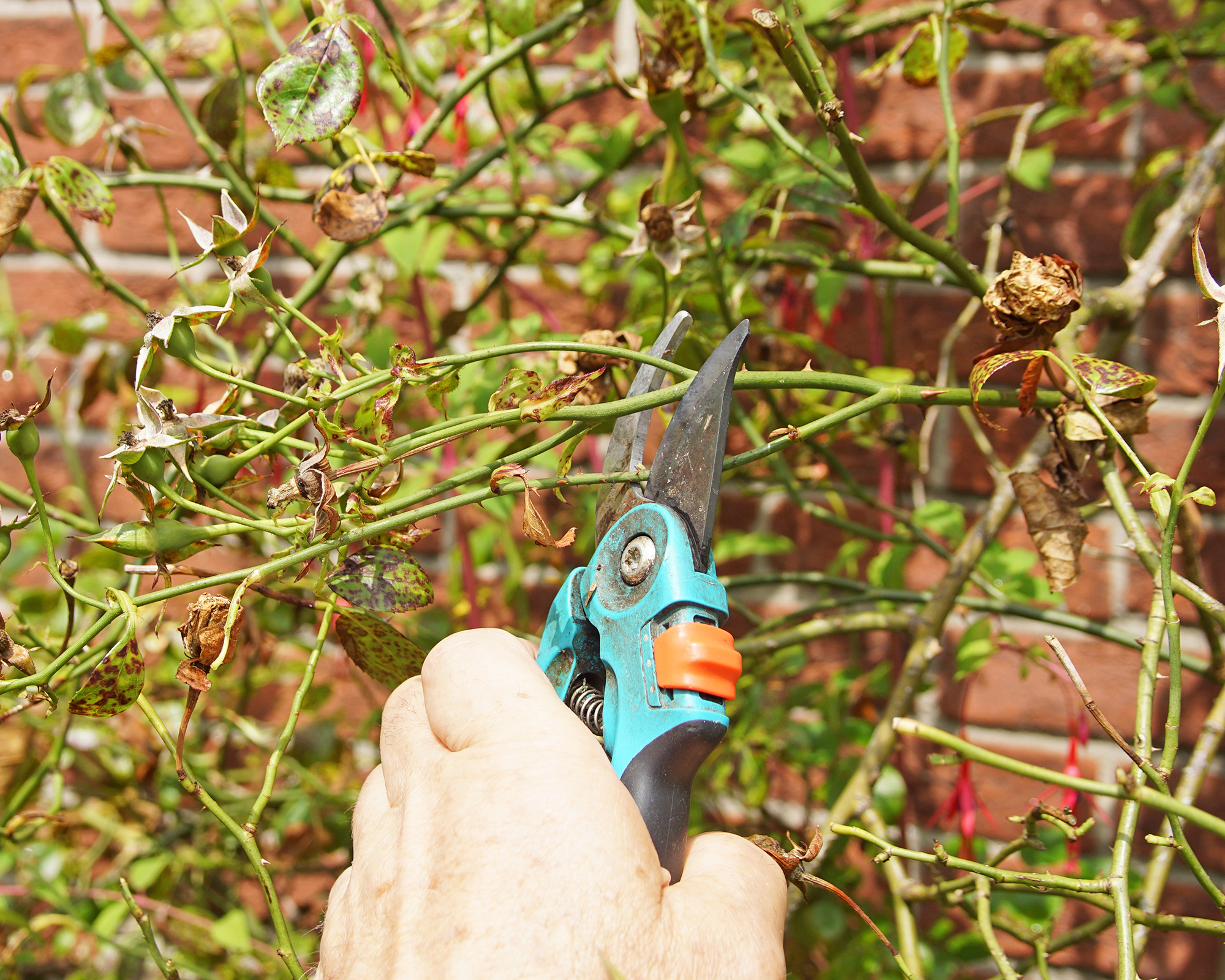
Pruning Climbing Roses
Pruning climbing roses is a vital part of their care and training. While damaged or diseased canes can be removed as and when required, the main pruning should take place between late winter and early spring. The exception is when you are pruning rambling roses, which should be done after flowering in late summer.
While many of the techniques of pruning roses are the same as bush roses, there are some key differences. The main difference is that the long main canes should not be cut back, as these provide the overall structure. Instead, it is the lateral side shoots that should be pruned away. You also need to remove rose suckers or canes growing in the wrong direction.
Remove old canes on climbing roses if they are underperforming or are difficult to train. Leave the best 4-6 canes to form the overall structure.
Propagating
Propagating climbing roses is surprisingly easy and an enjoyable way to grow your collection or make plants to give as gifts. The most effective method is to propagate roses from cuttings, with hardwood cuttings taken in the fall to winter usually the most reliable.
Simply choose a healthy-looking cane from this year's growth, about the thickness of a pencil. Cut it into sections about 8 to 12 inches (20 to 30cm) in length, ensuring there are at least three buds on each section. The top cut should be just above the top bud, and the bottom cut just below the bottom bud. Insert the cutting into gritty compost, burying at least two-thirds under the soil. Keep the soil moist, and roots should develop by spring.
Alternatively, you can propagate roses by taking softwood cuttings in late spring or early summer, although they require a bit more care and attention.
Problems, Pests & Diseases
Climbing roses can be prone to common rose diseases and pests. The usual suspects are aphids, black spot, and powdery mildew.
You can minimize the risk of disease with good hygiene: clean up fallen leaves, ensure good airflow, and use sterilized pruners when cutting. Where disease is of particular concern, plant new varieties bred for disease resistance.
Keep an eye out for pests, using a homemade insecticidal soap or neem oil to treat infestations, and consider introducing natural predatory insects, like ladybugs.

Melanie is an experienced gardener and has worked in homes and gardens media for over 20 years. She previously served as Editor on Period Living magazine, and worked for Homes & Gardens, Gardening Etc, Real Homes, and Homebuilding & Renovating. Melanie has spent the last few years transforming her own garden, which is constantly evolving as a work in progress. She is also a passionate organic home grower, having experimented with almost every type of vegetable at some point. In her home, Melanie tends to an extensive houseplant collection and is particularly fond of orchids.
